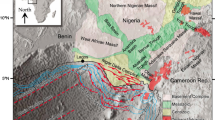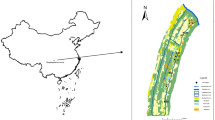Abstract
Levels of polycyclic aromatic hydrocarbons (PAHs) were measured in surface soils of Datuo karst Tiankeng (large sinkholes) in South China with the use of a gas chromatography–mass spectroscopy (GC–MS) system. This paper provides data on the levels and distribution of PAHs from the top to the bottom of the Datuo karst Tiankeng. The results showed that the sum of the 16 EPA priority PAHs from the sampled locations from top to bottom had a relative increment in PAHs concentration. ∑PAHs ranged from 16.93 ng/g to 68.07 ng/g with a mean concentration of 42.15 ng/g. The correlated results showed the bottom of the large sinkhole, which accounts for the higher concentrations, probably acts like a trap for the PAHs. Thus, the low evaporation rate at the bottom may play a key role in controlling the high concentration of PAHs at the bottom.
Similar content being viewed by others
Explore related subjects
Discover the latest articles, news and stories from top researchers in related subjects.Avoid common mistakes on your manuscript.
Introduction
Polycyclic aromatic hydrocarbons (PAHs) are widespread pollutants in the environment which are normally formed in combustion processes of carbonaceous materials at high temperatures. These combustion processes include emissions from automobiles, industrial processes, domestic heating systems, waste incineration facilities, tobacco smoke, forest fires, volcanic activities, and several other sources (Allen et al. 1996).
In China, the total PAH emission was estimated at about 25,300 tons in 2003 (Tao 2006). The major sources were determined as biofuel burning, domestic coal combustion, and coke production. In recent years, scientists have become increasingly concerned about the distribution and fate of organic pollutants like PAHs in the tropical and subtropical regions of Asia (Tanabe 1991; Iwata et al. 1994) because the tropical mild to high temperatures and heavy rainfalls are able to rapidly dissipate PAHs into the atmosphere, soil, and aquatic systems from points of discharge or usage. The “global distillation or fractionation” hypothesis (Wania and Mackay 1996; Bignert et al. 1998) suggests that semivolatile and persistent organic pollutants may be distilled or fractionated by differential temperatures around the globe. As a result, these chemicals tend to redistribute from tropical point sources to high latitude areas via single-hop pathways (Bignert et al. 1998) or multi-hop pathways (Wania and Mackay 1996) based on their volatility and ambient temperatures (Simonich and Hites 1995).
The goals of this study include:
-
1.
Providing data on the concentration levels of PAHs in Datuo Tiankeng
-
2.
Comparing the concentration variations from the top to the bottom of the Datuo Tiankeng
-
3.
Providing reasons why there are variations in concentrations
-
4.
Inferring the probable source of the PAHs
Study site
Datuo karst Tiankeng is located in Leye County in the Guangxi province of South China (Fig. 1). Leye is about 456 km from Nanning the capital of Guangxi province and it covers an area of about 2,617 km2. Datuo Tiankeng lies within the Dashiwei tiankeng group which is at longitude 106°21′49″ ∼ 106°40′30″ E and latitude 24°51′40″ ∼ 24°56′06″ N, and it is about 290 m deep and 523 m in entrance diameter.
Tiankeng is a special Chinese name that has scientifically been accepted to mean large collapsed karst sinkhole. They are generally the youngest negative karst landforms that are formed from carbonate rocks as a result of collapse of soluble sedimentary rock (generally carbonate rocks) during dissolution and suffusion in normal geological and hydrodynamic environments. The main feature of a Tiankeng is its very large size and its resemblance to a well or a pit. In China, there are about 50 karst Tiankengs known, and most are located within the Dashiwei group in South China because of favorable environmental conditions (Sweeting 1995).
Studies exists to show the levels of polycyclic hydrocarbons in soils in China and other parts of the world (Chen et al. 2004; Wang et al. 2007; Zhu et al. 2004; Wilcke and Amelung 2000; Wilcke et al. 2005), but no bibliographic reference or report exists to show any research has been done in the Tiankeng (sinkhole) soil for the presence of PAHs. Thus, the results acquired in this study provide the first, or background data, on the trends of PAHs in Tiankengs and contributes to our understanding of PAHs and their role in sinkholes such as Tiankengs.
Experiment section
Field and site sampling
Materials collected during the field work were surface soil samples. Physical soil sampling was done in all locations of the study area with the use of a hand shovel. The sampling was done sequentially within a depth of 230 m in two cross-sectional profiles AA and BB (Fig. 2). Profile AA had sampling sites from top to bottom within 230 m (from 1,300 m to 1,070 m), and profile BB had sampling sites just within 40 m depths (from 1,110 m to 1,070 m) around the bottom of the sinkhole. All samples were properly labeled with the coordinates of the locations (Table 1), and the samples were kept frozen prior to the commencement of the laboratory analysis.
Analytical procedures
In the laboratory, soil samples were dried for more than 24 h, pulverized, and sieved through a 100-meshed stainless steel mesh. A detailed standard analytical procedure, namely, extraction, separation, and gas chromatography–mass spectroscopy (GC–MS) analysis for the samples, was carried out. Briefly, a mixture of PAH surrogate standard (naphthalene-d8, acenaphthene-d10, phenan-threne-d10, chrysene-d12, and perylene-d12) was added to each of the samples prior to extraction. About 20 g of the samples were Soxhlet-extracted for 48 h with redistilled dichloromethane (DCM). The extracts were concentrated and solvent-exchanged to hexane and then purified using a 1:2 aluminum/silica column chromatography. The first fraction containing aliphatic hydrocarbons was eluded with 15 ml of hexane. The second fraction containing PAHs was eluted with 70 ml of a mixture of DCM and hexane (V:V 30:70). Next, the eluted solvent was vacuum-evaporated to 0.5 ml and concentrated to 0.2 ml under a gentle nitrogen stream. A known quantity of internal standard hexamethylbenzene was added to the samples prior to the instrumental analysis in order to quantify the PAHs concentrations.
PAHs were analyzed using Agilent 6890N/ 5975MSD GC-MS equipped with a 30 m × 0.25 mm i.d. DB-5 capillary column (0.25 μm membrane thickness) coupled with a HP-5972 mass selective detector operated in the electron impact mode (70 eV). The chromatographic conditions were as follows: injector temperature 260°C; detector temperature 180°C; oven temperature program 60°C (5 min), −290°C at 3°C/min, −290°C (40 min). The carrier gas was helium at a constant flow rate of 1.5 ml/min. A 1 μl concentrated sample was injected with splitless mode.
Quality control
Method blanks (solvent), duplicate samples, and spiked blanks (standards spiked into solvent) were analyzed. In addition, surrogate standards were added to each of the samples to monitor procedural performance and matrix effects. The recovery ratios for the surrogates in the samples conform to the reported ranges by US EPA. The concentrations of PAHs were corrected for the recovery ratios for the surrogates. Known quantity of internal standard hexamethylbenzene was added to the samples prior to the instrumental analysis in order to quantify the PAH concentrations.
Results and discussion
General distributions of PAHs
All the PAHs and their total surface soil concentrations are summarized in Table 2.
The ∑PAHs concentration measured in the whole study area varied from 16.93 ng/g to 68.07 ng/g with a mean concentration of 42.15 ng/g. Phenanthrene was the most abundant PAH detected with an average total site concentration of 9.69 ng/g, followed by naphthalene (7.51 ng/g), fluoranthene (3.71 ng/g), benzo[b]fluoranthene (3.54 ng/g), chrysene (3.11 ng/g), fluorene (2.98 ng/g), pyrene (1.99 ng/g), indeno[1,2,3-cd]pyrene (1.94 ng/g), anthracene (1.93 ng/g), and benzo[k]fluoranthene (1.62 ng/g). These listed PAHs contributed 90.24% of the total PAHs detected in this study.
In this paper, the 16 EPA priority pollutant PAHs were divided into three groups according to their molecular weight and benzene rings (Qi et al. 2000). The light group includes: naphthalene, acenaphthylene, acenaphthene, fluorene, phenanthrene, anthracene, and fluoranthene. The middle group includes: pyrene, benzo[a]anthracene, chrysene, benzo[b]fluoranthene, and benzo[k]fluoranthene; and the heavy group includes: benzo[a]pyrene, indeno[1,2,3-cd]pyrene, dibenz[a,h]anthracene, and benzo[ghi] perylene.
Sampling profile AA
This sampling profile had sample sites from the top of the sinkhole to the bottom (locations: L0, L1, L2, L3, L4, L5, and L10). ∑PAHs measured from profile AA had an average concentration of 35.45 ng/g. 71.5% of the total PAHs from these profiles was contributed by phenanthrene, naphthalene, fluoranthene, benzo[b]fluoranthene, chrysene, and fluorene. The other PAHs made up the remaining percentage. In this sampling profile, locations L5 and L0 had the highest and lowest PAH concentrations at 43.04 ng/g and 29.10 ng/g, respectively. The low concentration of L0 is as a result of its location, which is at the very top of the sinkhole where sunlight permits more evaporation than deposition such as is experienced around L5 (Fig. 3).
Sampling profile BB
This sampling profile was precisely at the bottom of the sinkhole (Fig. 2), and the average ∑PAHs concentration measured was 48.65 ng/g. 77.8% of the total PAHs from this profile were contributed by phenanthrene, naphthalene, benzo[b]fluoranthene, fluoranthene, chrysene, anthracene, and fluorene. The other PAHs contributed 22.2% of the total PAHs. Locations L7 and L8 had the highest and lowest PAH concentrations at 68.07 ng/g and 16.93 ng/g, respectively. The low concentration detected in L8 is due to the nature of its soil which is sandy clay. This will allow more infiltration when compared to the other sites that are mainly clay.
In summary, the difference in total concentration of PAHs between sites in profile AA and profile BB can generally be attributed to the difference in environmental conditions prevailing in both profile sections. Some of the sample locations in profile AA were collected at the top of the sinkhole, which receives a high amount of sunlight. In contrast, profile BB had all sample sites at the bottom of the sinkhole, which is characterized by a humid condition and receives a lesser amount of sunlight, thus resulting in more deposition than evaporation. Also, the presence of forest around this sampling profile (in L6 and L7) increases the amount of organic matter in the soil where PAHs can accumulate by adsorption.
The correlated results in all the sampled sites in both profiles showed that the light group PAHs were more abundant when compared to heavy group PAHs (which were more concentrated in the sampling sites at depth; profile BB). The reason for this is due to the differences in various physiochemical properties of these PAHs. The LMW PAHs have low weight and high volatility. As such, they are easily transported from source areas compared to the heavy molecular weight (HMW) PAHs with heavier weight, low volatility, and minimal transport. Even when the HMW PAHs are transported and deposited as seen in the sinkhole, they may be expected to keep recycling in the soil (organic matter)–water system rather than hopping up to higher altitudes under normal ambient temperature.
For sources of PAHs in this sinkhole, ratios of light molecular weight (LMW) PAHs (2-3 benzenoid rings) to the HMW PAHs (4-6 benzenoid rings) and phenanthrene to anthracene (PH/AN) were used to distinguish between petrogenic and pyrogenic sources of PAHs (Baumard et al. 1998). Petrogenic sources of PAHs contain mostly light molecular weight and are generated from geochemical alteration of organic matter from petroleum spills, coal-fired plants, and municipal sewage treatment facilities, whereas PAHs with 4-6 benzenoid rings are generated mainly through incomplete combustion of organic matter at temperatures usually above 400°C over a short time interval. These are mostly coal tar or petroleum tar products generated from manufactured gas production, and they are mainly termed as pyrogenic sources. A ratio of <1 suggests pyrogenic sources and a ratio >1 suggests petrogenic sources (Baumard et al. 1998). For the study area, the ratio between the LWM and the HMW was calculated. The result showed most ratios to be >1, inferring petrogenic PAHs in the soil in Datuo Tiankeng.
The high abundance of PAHs such as phenanthrene and naphthalene in this study area is an indicator of recent PAH input to this sinkhole and suggests the main route of transportation to be by air.
Correlation with historic data
This study is the first to investigate the levels of PAHs in surface soils of large karst sinkholes called Tiankengs. Although China has about 50 Tiankengs located in different locations or provinces, none has any report yet on any background concentration of PAHs. In addition, no results or information of any form exist to show the background levels of PAHs in other large karst sinkholes globally. But comparisons with the levels of PAHs in areas either close or related to this area in terms of geomorphology and geography were considered. Chen et al. (2004) and Zhu et al. (2004) reported ranges of 59.71–615.8 ng/g and 224–4,222 ng/g in Hangzhou soils. Wang et al. (2004) recorded a range from 190–8,595 ng/g in soils from Dalian. There are also records in remote or pristine European and US soils as seen in Moscow soils: 59–1,350 ng/g (Nikiforova and Alekseeva 2002; Wilcke et al. 2005) and North American Prairie: 63–321 ng/g (Wilcke and Amelung 2000). The reason for the lower concentration of PAHs in this study area when compared to soils of other historic studies can be attributed to the geographical location and the geology of the study site. The study site is in a pristine location: which is far from the PAH sources; as a result, some PAHs might be lost during transportation. Another reason for the low concentration could be the closeness of the study area to the tropic of cancer which will result in more evaporation and degradation of PAHs that are deposited in the surface soils. Moreover, the karstic nature of this area makes infiltration and percolation of PAHs from the surface soil to the underground water very easy and can account for the low levels detected.
References
Allen, J. O., Dookeran, N. M., & Smith, K. A., et al. (1996). Measurement of polycyclic aromatic hydrocarbons associated with a size-segregated atmospheric aerosols in Massachusetts. Environmental Science & Technology, 30, 1023–1031.
Baumard, P., Budzinski, H., & Garrigue, P. (1998). Polycyclic aromatic hydrocarbons in sediments and mussels of the western Mediterranean Sea. Environmental Toxicology and Chemistry, 17, 765–776.
Bignert, A., Olsson, M., Persson, W., Jensen, S., Zakrisson, S. Litzen, K., Eriksson, U., Haggberg, L., & Alsberg, T. (1998). Temporal trends of organochlorines in Northern Europe. Environmental Pollution, 99, 177–198.
Chen, B., Xuan, X., Zhu, L., Wang, J., Gao, Y., Yang, K., Shen, Y., & Lou, B. (2004). Distributions of polycyclic aromatic hydrocarbons in surface waters, sediments and soils of Hangzhou city, China. Water Research, 38(16), 3558–3568.
Iwata, H., Tanabe, S., Sakai, N., Nichimura, A., & Tatsukawa, R. (1994). Geographical distribution of persistent organochlorines in air, water and sediments from Asia and Oceania and their implications for global redistribution from lower latitudes. Environmental Pollution, 85, 15–33.
Nikiforova, E. M., & Alekseeva T. A., (2002). Polycyclic aromatic hydrocarbons in the soils of roadside ecosystems of Moscow. Eurasian Soil Science, 35, 42–52.
Qi, S., Yan, J., & Zhang, G., et al. (2000). Distribution of polycyclic aromatic hydrocarbons in aerosols and dust fall in Macao. Environmental Monitoring and Assessment, 72, 115–127.
Simonich, S. L., & Hites, R. A. (1995). Global distribution of persistent organochlorine compounds. Science, 269, 1851–1854.
Sweeting, M. M. (1995). Karst in China, its geomorphology and environment. Berlin: Springer, pp 265.
Tanabe, S. (1991). Fate of toxic chemicals in the tropics. Marine Pollution Bulletin, 22, 259–260.
Tao, S. (2006). Emission, fate and sources apportionment of polycyclic aromatic hydrocarbons. College of Environmental Sciences, Peking Unviersity, Beijing, China.
Wania, F., & Mackay, D. (1996). Tracking the distribution of persistent organic pollutants. Environmental Science & Technology, 30, 390A–396A.
Wang, Z., Chen, J., Yang, P., Qiao, X., & Tian, F. (2007). Polycyclic aromatic hydrocarbons in Dalian soils: distribution and toxicity assessment. Journal of Environmental Monitoring, 199–204.
Wilcke, W., & Amelung, W. (2000). Persistent organic pollutants in native grassland soils along a climosequence in North America. Soil Science Society of America Journal, 64, 2140–2148.
Wilcke W, Krauss, M., Safronov, G., Fokin, A. D., & Kaupenjohann, M. (2005). Polycyclic aromatic hydrocarbons (PAHs) in soils of the Moscow region—concentrations, temporal trends, and small-scale distribution. Journal of Environmental Quality, 34, 1581–1590.
Zhu, L., Chen, B., Wang, J., & Shen, H. (2004). Pollution survey of polycyclic aromatic hydrocarbons in surface water of Hangzhou, China. Chemosphere, 56(11), 1085–1095.
Acknowledgement
This work was supported by the Natural Scientific Foundation of China (No. 40473043).
Author information
Authors and Affiliations
Corresponding authors
Rights and permissions
About this article
Cite this article
Theodore, O.I., Qi, S., Kong, X. et al. Distribution of polycyclic aromatic hydrocarbons in Datuo karst Tiankeng of South China. Environ Geochem Health 30, 423–429 (2008). https://doi.org/10.1007/s10653-007-9126-9
Received:
Accepted:
Published:
Issue Date:
DOI: https://doi.org/10.1007/s10653-007-9126-9







